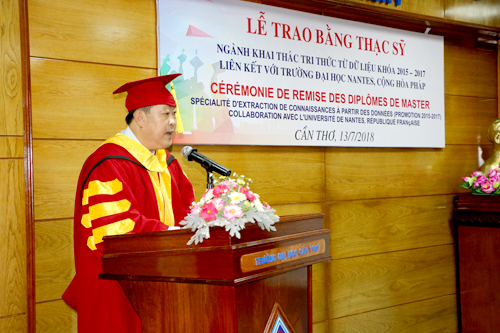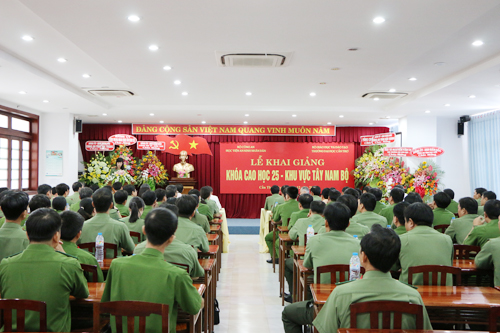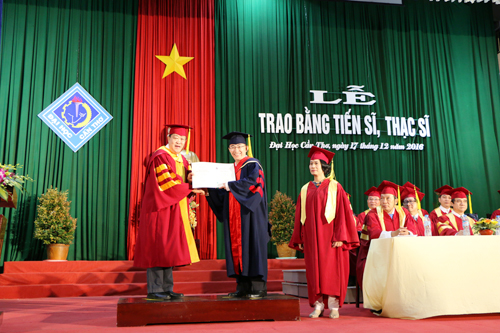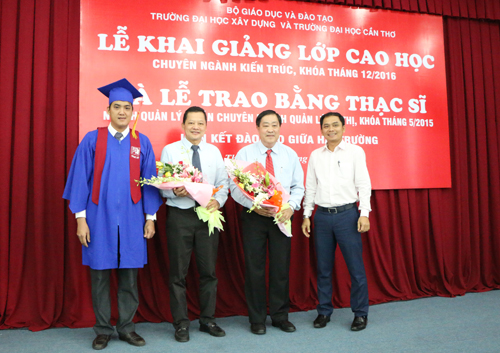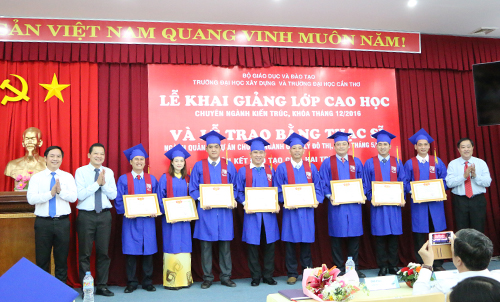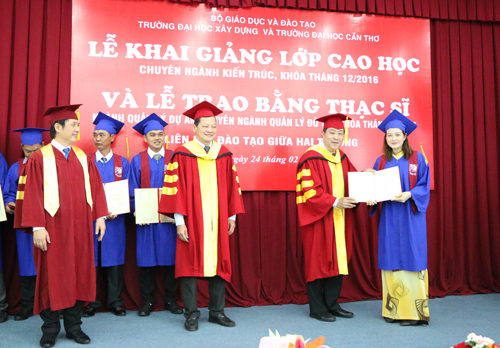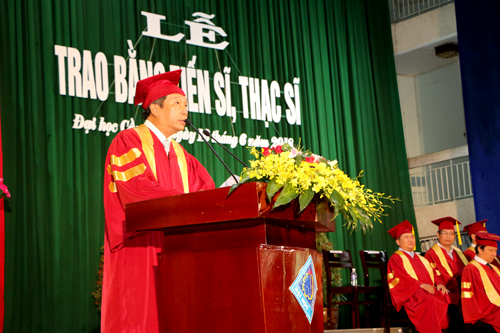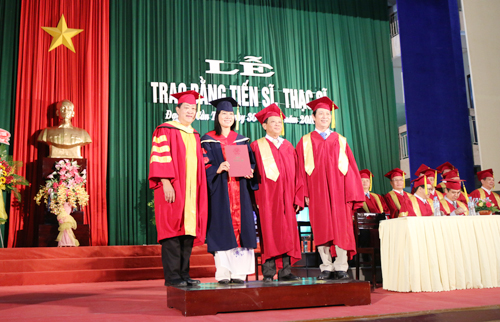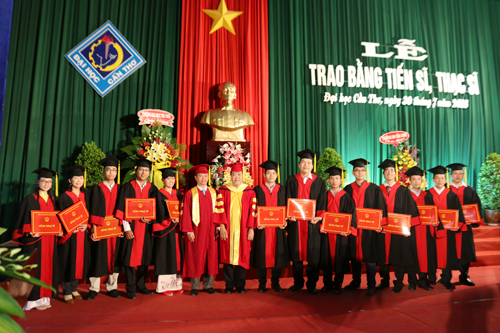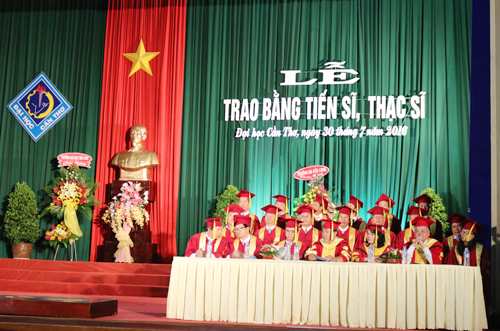
 Tên đề tài: “Nghiên cứu đặc điểm hình thái, sinh học và đánh giá hiệu quả của các chủng nấm Beauveria và Paecilomyces ký sinh trên côn trùng gây hại được phân lập tại Đồng bằng Sông Cửu Long”.
Tên đề tài: “Nghiên cứu đặc điểm hình thái, sinh học và đánh giá hiệu quả của các chủng nấm Beauveria và Paecilomyces ký sinh trên côn trùng gây hại được phân lập tại Đồng bằng Sông Cửu Long”.
 Tác giả: Huỳnh Hữu Đức, Khóa: 2013
Tác giả: Huỳnh Hữu Đức, Khóa: 2013
 Chuyên ngành: Bảo vệ thực vật; Mã số: 62620112. Nhóm ngành: Nông, lâm nghiệp và thuỷ sản.
Chuyên ngành: Bảo vệ thực vật; Mã số: 62620112. Nhóm ngành: Nông, lâm nghiệp và thuỷ sản.
 Người hướng dẫn chính: PGS.TS. Trần Văn Hai - Trường Đại học Cần Thơ
Người hướng dẫn chính: PGS.TS. Trần Văn Hai - Trường Đại học Cần Thơ
- Tóm tắt nội dung luận án
Đề tài: “Nghiên cứu đặc điểm hình thái, sinh học và đánh giá hiệu quả của các chủng nấm Beauveria và Paecilomyces ký sinh trên côn trùng gây hại được phân lập tại Đồng bằng Sông Cửu Long” được thực hiện từ năm 2013 đến năm 2017 đạt được kết quả sau:
Đã thu thập được 16 chủng nấm Beauveria và 22 chủng nấm Paecilomyces tại các tỉnh vùng ĐBSCL như Cần Thơ, Vĩnh Long, Hậu Giang, An Giang, Kiên Giang, Sóc Trăng và Trà Vinh, gây bệnh trên nhiều loài côn trùng gây hại nhưng tập trung trên sùng khoai lang và rệp sáp. Kết quả quan sát, phân loại bằng hình thái học như hình dạng bào tử, cành bào đài, cơ quan sinh bào tử, kích thước bào tử kết hợp với kỹ thuật PCR, giải trình tự, so sánh và phân tích trình tự DNA trên vùng ITS-rDNA đã khẳng định 16 chủng phân lập Beauveria thuộc loài Beauveria bassiana; trong 22 chủng nấm Paecilomyces đã khẳng định 14 chủng nấm tím được phân lập ký hiệu từ Pae1 - Pae14 thuộc chi Paecilomyces là loài Paecilomyces javanicus và 8 chủng nấm tím còn lại thuộc chi Purpureocillum là loài Purpureocillum lilacinum.
Nghiên cứu đặc điểm sinh học của 16 chủng nấm B. bassiana và 14 chủng nấm P. javanicus cho thấy: Tỷ lệ nẩy mầm của các chủng nấm P. javanicus đạt trên 94% sau 20 GSKC sớm hơn so với các chủng nấm B. bassiana đạt trên 94% sau 24 GSKC. Môi trường SDAY3 và PDA luôn cho tốc độ phát triển đường kính khuẩn lạc nhanh và cho mật số bào tử cao, ngoài ra chủng nấm P. javanicus còn phát triển tốt trên môi trường CDA. Nhiệt độ tối hảo cho nấm B. bassiana và các chủng nấm P. javanicus phát triển đồng thời tạo nhiều bào tử là từ 25o - 28oC. Khi nhiệt độ tăng lên cao trên 30oC thì cả hai loài nấm đều phát triển chậm lại hoặc không phát triển được. Bào tử các chủng nấm B. bassiana và các chủng nấm P. javanicus có khả năng sống sót sau khi tiếp xúc với điều kiện nhiệt độ cao trong 8 giờ. Đa số thuốc hoá học trừ nấm bệnh có ảnh hưởng bất lợi đến sự phát triển và nẩy mầm của nấm B. bassiana và nấm P. javanicus ở nồng độ (LKC) và (2 x LKC).
Dựa vào kết quả nghiên cứu đặc điểm sinh học và bước đầu đánh giá hiệu lực của 16 chủng nấm B. bassiana và 14 chủng nấm P. javanicus, tuyển chọn được chủng Bb4(SKL-VL), Bb5(SKL-HG), Pj6(Pl-TG) và Pj8(Pl-CT) để sản xuất chế phẩm dạng tươi theo quy trình nhân nuôi nấm được nêu ở phụ chương.
Đánh giá hiệu lực của chế phẩm nấm B. bassiana trong phòng trừ thành trùng SKL C. formicarius (Fabricius) và chế phẩm P. javanicus trong phòng trừ thành trùng rệp sáp P. lilacinus (Cockerell) ở điều kiện PTN và nhà lưới thì cả hai chế phẩm đều đạt hiệu quả cao trên 80% sau 7 - 11 ngày phun chế phẩm với nồng độ bào tử chế phẩm từ 108 - 109 (bt/mL) và liều lượng chế phẩm từ 3,0 kg/ha và 3,5 kg/ha. Kết quả đánh giá hiệu lực của chế phẩm nấm B. bassiana và P. javanicus trên diện hẹp ở điều kiện ngoài đồng ruộng cho thấy, khi phun 5 lần chế phẩm nấm B. bassiana để phòng trừ SKL và 3 lần chế phẩm P. javanicus để phòng trừ rệp sáp với liều lượng 3,0 kg/ha cho hiệu quả tương đương với biện pháp sử dụng thuốc hoá học theo nông dân. Vì vậy, các kết quả thu được trong nghiên cứu này là cơ sở để khuyến cáo ứng dụng nấm ký sinh B. bassiana và P. javanicus như một tác nhân kiểm soát sinh học trong các chương trình IPM, để thay thế các loại thuốc hóa học cũng là cơ sở cho hướng nghiên cứu tiếp theo trong lĩnh vực đấu tranh sinh học côn trùng.
- Những kết quả mới của luận án
Phân lập được 16 chủng nấm Beauveria ký sinh trên côn trùng tại 7 tỉnh ĐBSCL thuộc loài B. bassiana. Trong đó, tuyển chọn được hai chủng Bb4(SKL-VL) và Bb5(SKL-HG) để sản xuất chế phẩm.
Phân lập được 22 chủng nấm Paecilomyces ký sinh trên côn trùng tại 6 tỉnh ĐBSCL trong đó định danh được 14 chủng nấm thuộc loài P. javanicus và 8 chủng nấm thuộc loài Purpureocillum lilacinum. Kết quả, tuyển chọn được hai chủng Pj6(Pl-TG) và Pj8(Pl-CT) để sản xuất chế phẩm.
Xác định được một số yếu tố ảnh hưởng đến sự sinh trưởng và phát triển của nấm B. bassiana và P. javanicus trong điều kiện phòng thí nghiệm.
Xác định một số hoạt chất hoá học trừ nấm vô hại đối với sự phát triển của nấm B. bassiana ở nồng độ thấp (½ nồng độ liều khuyến cáo) hoặc ảnh hưởng vừa (ở nồng độ liều khuyến cáo) như Metalaxyl, Fenoxanil và Validamycin. Đối với P. javanicus hợp chất Fenxanil, Kasugamycin và Picoxystrobin tỏ ra vô hại hoặc ảnh hưởng vừa. Tuy nhiên, đối với nấm B. bassiana rất dễ bị ảnh hưởng ngay cả nồng độ rất thấp (½ nồng độ liều khuyến cáo) so với P. javanicus trên cùng hợp chất thuốc hoá học trừ nấm.
Đối với chế phẩm nấm B. bassiana dạng tươi để phòng trừ SKL và chế phẩm nấm P. javanicus dạng tươi để phòng trừ rệp sáp P. lilacinus gây hại mãng cầu xiêm đều cho kết quả phòng trừ tốt khi sử dụng liều lượng 3,0 - 3,5 kg/ha với mật số bào tử chế phẩm khoảng > 108 bt/gram.
- Các ứng dụng/khả năng ứng dụng trong thực tiễn, các vấn đề cần tiếp tục nghiên cứu
Kết quả nghiên cứu chi tiết có hệ thống từ trong phòng thí nghiệm, nhà lưới đến ngoài đồng ruộng nên cung cấp nhiều số liệu khoa học về đặc điểm hình thái, sinh học và đánh giá hiệu lực của nấm Beauveria bassiana và Paecilomyces javanicus nhằm thiết lập những thông tin cơ bản về các chủng nấm phân lập tại ĐBSCL. Ngoài ra, kết quả của đề tài sẽ mở ra hướng quản lý phòng trừ một số loài côn trùng gây hại cây trồng theo IPM, để thay thế các loại thuốc hóa học cũng là cơ sở cho hướng nghiên cứu tiếp theo về đấu tranh sinh học côn trùng.
Tiếp tục nghiên cứu đánh giá hiệu lực ở điều kiện ngoài đồng trên diện rộng và đánh giá hiệu lực trên các ký chủ khác của hai chế phẩm nấm B. bassiana và P. javanicus.
1. Brief contents dissertation titled “Study on morphological, biological characteristics and efficacy of species in genus Beauveria and Paecilomyces infecting plant herbivores harmful insects in Mekong Delta” had done from 2013 to 2017. The results are as follows:The results are collected of 16 fungal strains of the genus Beauveria and 22 fungal strains of the genus Paecilomyces in the provinces of the Mekong delta such as Can Tho, Vinh Long, Hau Giang, An Giang, Kien Giang, Soc Trang and Tra Vinh. They are infecting plant herbivores harmful insects, but concentrated on sweet potato weevil and mealybugs. From identification results by traditional methods based on the morphological characteristics, shape and size of fungal conidia, structure of conidiophores, PCR technique amplifying the ITS-rDNA regions and the phylogenetic analyses results based on the ITS-rDNA sequences, then all 16 fungal strains of Beauveria are isolated well in line with characteristics of Beauveria bassiana species and then 22 fungal strains of Paecilomyces, 14 fungal strains are identified from Pae1 - Pae14 belonging to genus Paecilomyces and identified species as Paecilomyces javanicus. The eight remaining fungal strains are denoted by Pae15 - Pae22 belonging to the genus Purpureocillum and identified species as Purpureocillum lilacinum The biological characteristics of 16 strains B. bassiana and 14 strains P. javanicus showed that the germination rate of strains P. javanicus was over 94% at 20 hours after cultivation, earlier than the germination rate of strains B. bassiana was over 94% at 24 hours after cultivation. The SDAY3 and PDA medium have given the quick speed of colonies diameter and high density of conidia, furthermore strains P. javanicus can grow well when P. javanicus was cultivated on CDA medium. The time for strains B. bassiana and P. javanicus gave the highest spores number at 14 days after cultivation and there are the high density of conidia about ((107 - 108 conidia) x cm-2). The optimal temperature for strains B. bassiana and P. javanicus development as well as many conidia production were about 25o - 28oC. When the temperature increased above 30oC, both B. bassiana and P. javanicus grew slowly or did not grow. The spores of B. bassiana and P. javanicus were able to survive after coming in contact with high temperature conditions for 8 hours. Almost all fungicides had effected on the growth and germination of B. bassiana and P. javanicus at recommended doses and double recommended doses concentrations Based on the results of a study on some biological characteristics of B. bassiana and initial evaluation of B. bassiana fungal strains on Cylas formicarius in laboratory conditions. The strains Bb4(SKL-VL), Bb5(SKL-HG), Pj6(Pl-TG) and Pj8(Pl-CT) are selected to produce fresh powder of B. bassiana fungi inoculant according to mass production produces of fungi described in the subchapter of thesis. The evaluative efficacy of parasitic fungi B. bassiana for the control of sweet potato weevil C. formicarius and parasitic fungi P. javanicus for the control of mealybug P. lilacinus were carried out in in-vitro and nethouse conditions. The results of using parasitic fungi B. bassiana and P. javanicus showed that two parasitic fungi showed high effect over 80% after 7 - 11 days following treatment of fresh powder fungi preparation with the concentration of spores from 108 to 109 conidia/mL and the dose of fresh powder fungi inoculant from 3,0 to 3,5 kilograms/ha. The results evaluated the efficacy of parasitic fungi B. bassiana and P. javanicus when experiments were carried out in the field, were sprayed five times by fresh powder fungi inoculant B. bassiana for the control of C. formicarius were spayed for the control of P. lilacinus with the dose of fresh powder fungi preparation from 3,0 kilograms/ha, the results of all experiments gave equivalent effects with using chemistry by famers’ methods. Therefore, collected data in this research, which is the basis to recommend for applying successfully entomopathogenic fungi as a biocontrol agent in the IPM programmes.2. The new findings of the dissertation Sixteen Beauveria isolates on insects collected at 7 provinces of the Mekong delta belong to one entomopathogenic Beauveria bassiana species. Among them, Two isolates of Bb4(SKL-VL) and Bb5(SKL-HG) were selected for fungi inoculant production. Twenty two Paecilomyces isolates on insects collected at 6 provinces of the Mekong delta that identified 14 isolates of P. javanicus species and 8 isolates of the Purpureocillum lilacinum species. As a result, two strains of Pj6(Pl-TG) and Pj8(Pl-CT) were selected for preparation production. Identification of some factors affecting the growth and development of B. bassiana and P. javanicus laboratory conditions. Identification of some harmless chemical fungicides for the development of B. bassiana in low concentration (at ½ recommended doses) or moderate effects (at recommended doses) such as Metalaxyl, Fenoxanil and Validamycin. As for P. javanicus the compounds Fenxanil, Kasugamycin and Picoxystrobin are harmless or moderate. However, B. bassiana is very susceptible to even very low concentrations (at ½ recommended doses) compared to P. javanicus on the same chemical active ingredients compound fungicides. For fresh powder of B. bassiana fungi inoculant to control C. formicarius and fresh powder of P. javanicus fungi inoculant to control P. lilacinus causing harm to soursop tree (Annona muricata), good results were obtained when using the dose of fungi inoculant from 3.0 to 3.5 kilograms/ha with the concentration conidia from >108 conidia mL-1.3. Applications and suggestions for further study The research has a highly scientific significance because it is a basis and systematic research from laboratory, net house to field conditions so it should provide multiple scientific data on morphological and biological characteristics and assess the effectiveness of B. bassiana and P. javanicus to establish basic information about entomopathogenic fungi in the Mekong Delta. Therefore, collected data in this research, which is the basis to recommend for applying successfully entomopathogenic fungi as a biocontrol agent in the IPM programmes, replace or alternate with chemical pesticides as well as create the database for further researches on the biological control of insect.Continue to study, researching effectivenss evaluation on wide range of field conditions and effectiveness evaluation on other hosts of two fresh powder fungi inoculant Beauveria bassiana and Paecilomyces javanicus.
- Xem chi tiết nội dung luận án
- Xem thông tin đăng tải tại Website Bộ giáo dục và Đào tạo. (Nhập tên NCS vào ô tìm kiếm)





